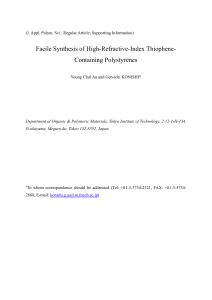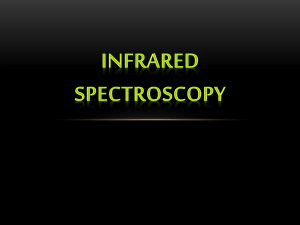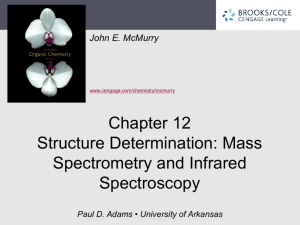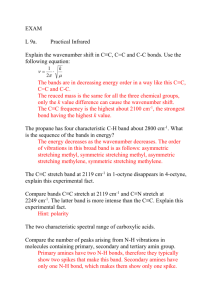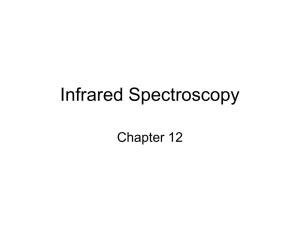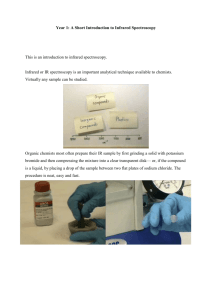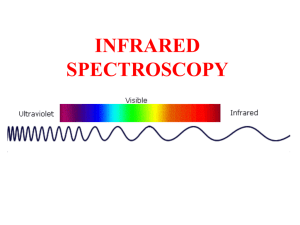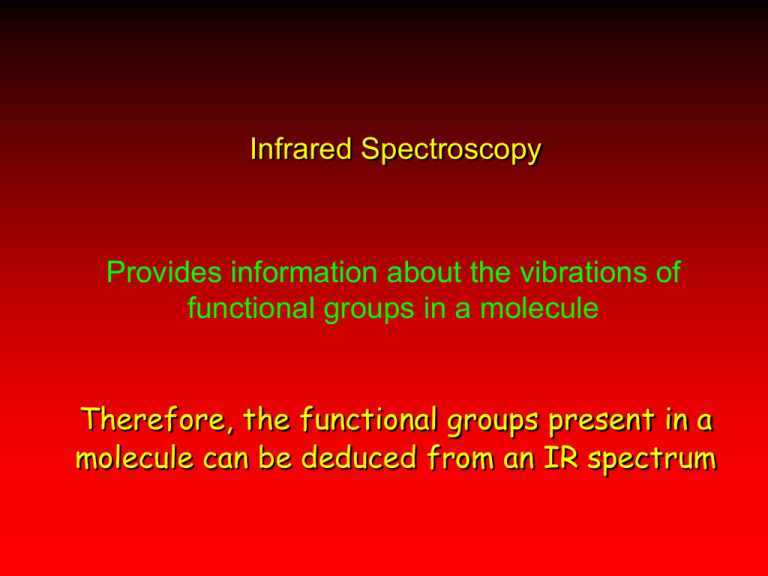
Infrared Spectroscopy
Provides information about the vibrations of
functional groups in a molecule
Therefore, the functional groups present in a
molecule can be deduced from an IR spectrum
Two important parameters in all IR spectra:
The frequency of the signal,
The intensity of the signal, I
What structural features of a molecule do
and I depend on?
The functional group concept of organic chemistry
IR spectroscopy can identify functional groups!
Some Important and Charac teristic Infrare d Absorption Frequencies and
Wave lengths for Some Common Stretching Motions
Atom Group
Typi cal of
Frequency (c m-1)
Wavelength ()
O-H (free)
O-H (H bonded)
Alcoho ls (dilute)
Alcoho ls
(concen trated)
Carboxy li c acids
Acetylene (CH)
Benzene ( CH),
Ethy le ne (CH)
Ethane (CH)
Acetylene
Nitr ile s
Carbony l
Alkene
Alkane
Alcoho ls ,
Ethers
3550-3650 c m-1
3200-3400 c m-1
2.8
3.0
3300 cm-1
3010-3100 c m-1
3.0
3.3
2950-3000 c m-1
2100-2260 c m-1
2000-2300 c m-1
1650-1750 c m-1
1620-1680 c m-1
600-1500 c m-1
1000-1300 c m-1
3.5
4.5
4.5
5.5- 6.0
6.0
6.7-17
10-7.7
C
C
C
C
H
H
C_____C_____H
C
C
C
C
C
C
C
N
O
C
C
O
In gen eral we will only be using the d ata in an IR spectrum for stretching v ibration s
which have ene rgies higher than 1620 cm-1. Although the b ands a t lower ene rgy a re
known and assigned , the region b elow 1620 c m-1 is very conge sted with single bond
stretche s of two heavy atoms (see C-C and C-O in table) and C-H bend s and a re beyond
the scope of wha t we want to do.
n-Hexane: CH3CH2CH2CH2CH2CH3
?
1650 cm-1
3100 cm-1
1-Hexene: CH2=CHCH2CH2CH2CH3
n-Hexane: CH3CH2CH2CH2CH2CH3
3-heptanone:
H3C
CH2
CH2
O
CH2 CH
3
CH2
n-Hexane: CH3CH2CH2CH2CH2CH3
1-Hexanol: CH3CH2CH2CH2CH2CH2OH
What in
the
world is
this
peak
due to?
Where are
the saturated
C-H stretches?
CH3CH2CH2CH2CH2CH3
n-hexane
Where are
the saturated
C-H stretches?
CH3CH3
H3C C C CH3
H H
2,3-dimethyl butane
What’s this?
Where are
the C-H stretches?
CH2 CHCH2CH2CH2CH3
Where are
the =C-H stretches?
Where is
the C=C stretch?
1-hexene
Why are the =C-H
stretches of lower
intensity than the
saturated C-H stretches?
Where is the
the C N stretch?
CH3CH2CH2CH2CH2CH2CH2C N
1-heptyl cyanide
Where is the
C C stretch?
Where is the C-H
stretch of C C H ?
HC CCH2CH2CH2CH2CH3
1 - he p tyne
Where is the
O
C
stretch?
O
CH3CH2C CH2CH2CH2CH3
3 - he p tan o n e
Why is
the C-H
stretch so
small
compared
to the
other
spectra?
Where is the
O
C
stretch?
O
H3C C OCH2CH3
EthylAce tate
What in
the world
is this
peak due
to?
Where is the
O
stretch?
C
O
CH3CH2CH2CH2CH2CH2C H
1 - h e p tan al
Where is the
OH stretch?
Where is the
C=O stretch?
CH3CH2CH2CH2CH2CH2OH
1 - h e p tan o l
Where is the
OH stretch?
Where is the
O
O
C
stretch?
CH3CH2CH2CH2CH2CH2COH
1 - He p tano licAcid
IR: Masses, Atoms and Springs
A Model: Picture the atoms of a diatomic molecule
as point masses connected by springs (bonds).
As a first approximation use Hooke’s Law
F = -kx
F = force, restoring back to equilibrium
position
k = characteristic stretching constant
x = displacement from the equilibrium
position
IR Stretching Frequencies of two
bonded atoms:
What Does the Frequency, ,
Depend On?
1
2
= frequency
k
mr
m1 m2
mr
m1 m 2
k = spring strength (bond stiffness)
mr = reduced mass (~ mass of largest atom)
Vibrations, potential energy and motion
X Y
X
a
F = d PE/ dr
Y
b
X
PE
Y
X
c
d
re
re
Internuclear
separation
Internuclear
separation
r
X
Y
Light atoms
and / or
strong bonds
Y
X
Y
Heavy atoms
and /or
weak bonds
IR Stretching Frequencies: What Do
they Depend On?
Directly on the strength of the bonding
between the two atoms ( ~ k)
Inversely on the reduced mass of the two
atoms (v ~ 1/m)
Expect: will increase with increasing bond
strength (bond order) and decreasing mass
Examples of stretching frequencies and
correlations with bond strengths (bond
order)
Bond strength* Bond order
C=C
C
1
1000 cm-1
600
2
1600 cm-1
840
3
2200 cm-1
350
C-C
C
*In kJ/mol
For same reduced mass!
Quantum mechanics: The frequency () depends
on the energy gap between vibrational levels
E = h= hc/(cm-1)
Only the natural frequency will be absorbed
The natural frequency (8.67 x 1013 s-1) is
absorbed selectively
What does the absorption intensity depend on?
The absorption intensity depends on how efficiently the
energy of an electromagnetic wave of frequency can be
transferred to the atoms involved in the vibration
The greater the change in dipole moment during a vibration,
the higher the intensity of absorption of a photon
Dipole Moment Must Change during
for a vibration to be “IR active”!
• In order to interact
strongly with the EM
radiation, the motion
of the molecule must
be such that the dipole
moment changes.
Which of the vibrations are “IR” active”?
What is the intensity of an IR signal of:
O2 or N2 or H2?
Ans: In order to absorb infrared radiation, a
molecular vibration must cause a change in the
dipole moment of the molecule
O2, N2 and H2 DO NOT ABSORB IR LIGHT!
The are not “Greenhouse” gases
Does O=C=O absorb IR light?
Ans: vibrations of O=C=O which cause a
change in the dipole moment of the molecular
absorb IR light
vibrations of O=C=O which do not cause a
change in the dipole moment of the
molecular DO NOT absorb IR light
No dipole
Dipole
generated
generated
Which should have a higher stretching
frequency, CO, CO+, or CO-? Why?
Ans: The higher the bond order, the stronger the
bond and the higher the frequency for the IR
stretch.
CO = ()2()4 CO+ = ()2()3 CO- = ()2()4()1
Bond order: CO = 3, CO+ = 5/2, CO- = 5/2
CO will have the higher stretching frequency
CO+ and CO- will have similar, lower frequencies
IR Stretching Frequencies of two
bonded atoms:
What Does the Frequency, ,
Depend On?
1
2
= frequency
k
mr
m1 m2
mr
m1 m 2
k = spring strength (bond stiffness)
mr = reduced mass (mass of largest atom)
The influence of reduced mass on the stretching
frequency
For any X-H bond the reduced mass is
approximately equal to the mass of the very
light hydrogen atom = 1
For a C-C bond the reduced mass is
approximately equal to the mass of a carbon
atom = 12
From the formula for , compute the differences
in for a X-H and C-C bond of equal strengths.
Infrared Spectroscopy: further review
region of infrared that is most useful lies between
2.5-16 m (4000-625 cm-1)
depends on transitions between vibrational
energy states
stretching
bending
Stretching Vibrations of a CH2 Group
Symmetric
Antisymmetric
Bending Vibrations of a CH2 Group
In plane
In plane
Bending Vibrations of a CH2 Group
Out of plane
Out of plane
Infrared Spectrum of Hexane
bending
C—H stretching
bending
bending
CH3CH2CH2CH2CH2CH3
3500
3000
2500
2000
1500
1000
Wave number, cm-1
Francis A. Carey, Organic Chemistry, Fourth Edition. Copyright © 2000 The McGraw-Hill Companies, Inc. All rights reserved.
500
Infrared Spectrum of 1-Hexene
C=C
H—C
C=C—H
H2C=C
H2C=CHCH2CH2CH2CH3
3500
3000
2500
2000
1500
1000
Wave number, cm-1
Francis A. Carey, Organic Chemistry, Fourth Edition. Copyright © 2000 The McGraw-Hill Companies, Inc. All rights reserved.
500
Infrared Absorption Frequencies
Structural unit
Frequency, cm-1
Stretching vibrations (single bonds)
sp C—H
3310-3320
sp2 C—H
3000-3100
sp3 C—H
2850-2950
sp2 C—O
1200
sp3 C—O
1025-1200
Infrared Absorption Frequencies
Structural unit
Frequency, cm-1
Stretching vibrations (multiple bonds)
C
1620-1680
—C
C—
2100-2200
—C
N
2240-2280
C
Infrared Absorption Frequencies
Structural unit
Frequency, cm-1
C
O
Stretching vibrations (carbonyl groups)
Aldehydes and ketones 1710-1750
Carboxylic acids
1700-1725
Acid anhydrides
1800-1850 and 1740-1790
Esters
1730-1750
Amides
1680-1700
Infrared Absorption Frequencies
Frequency, cm-1
Structural unit
Bending vibrations of alkenes
RCH
CH2
910-990
R2C
CH2
890
cis-RCH
CHR'
trans-RCH
R2C
CHR'
CHR'
665-730
960-980
790-840
Infrared Absorption Frequencies
Structural unit
Frequency, cm-1
Bending vibrations of derivatives of benzene
Monosubstituted
730-770 and 690-710
Ortho-disubstituted
735-770
Meta-disubstituted
750-810 and 680-730
Para-disubstituted
790-840
Infrared Spectrum of tert-butylbenzene
Ar—H
C6H5C(CH3)3
H—C
3500
3000
2500
Monsubstituted
benzene
2000
1500
1000
Wave number, cm-1
Francis A. Carey, Organic Chemistry, Fourth Edition. Copyright © 2000 The McGraw-Hill Companies, Inc. All rights reserved.
500
Infrared Absorption Frequencies: functional groups
Structural unit
Frequency, cm-1
Stretching vibrations (single bonds)
O—H (alcohols)
3200-3600
O—H (carboxylic acids)
3000-3100
N—H
3350-3500
Infrared Spectrum of 2-Hexanol
H—C
O—H
CH3CH2CH2CH2CHCH3
OH
3500
3000
2500
2000
1500
1000
Wave number, cm-1
Francis A. Carey, Organic Chemistry, Fourth Edition. Copyright © 2000 The McGraw-Hill Companies, Inc. All rights reserved.
500
Infrared Spectrum of 2-Hexanone
CH3CH2CH2CH2CCH3
O
H—C
C=O
3500
3000
2500
2000
1500
1000
Wave number, cm-1
Francis A. Carey, Organic Chemistry, Fourth Edition. Copyright © 2000 The McGraw-Hill Companies, Inc. All rights reserved.
500

